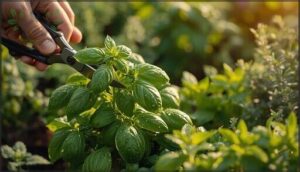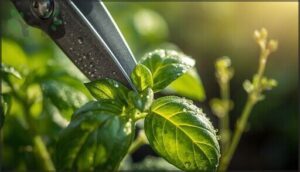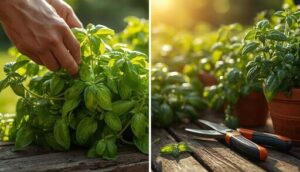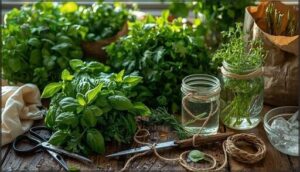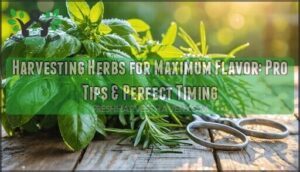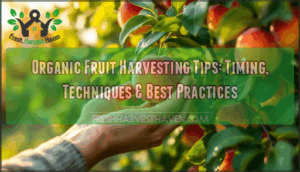This site is supported by our readers. We may earn a commission, at no cost to you, if you purchase through links.
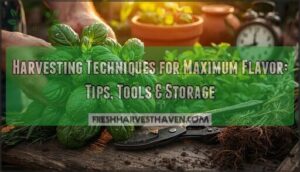
Morning basil contains up to 30% more of these precious oils than the same plant picked at noon. The difference between bland and flavorful doesn’t happen in your kitchen. It happens in those critical seconds when your shears meet the stem.
Master the right harvesting techniques and you’ll capture flavors that most people only taste at farm-to-table restaurants.
Table Of Contents
Key Takeaways
- Harvest herbs in the morning after dew dries to capture up to 30% more volatile oils than midday cuts, preserving the aromatic compounds that define bold flavor.
- Follow the one-third rule by removing no more than a third of any plant at once, cutting 0.5–1 cm above leaf nodes to trigger faster regrowth while maintaining 85–90% of essential oils.
- Use sharp, clean tools like bypass pruners or herb scissors to prevent cell damage and oxidation, then immediately cool herbs to lock in freshness and extend shelf life by days or weeks.
- Store dried herbs at proper humidity (90–95% RH) and temperature (0–5°C) in breathable or airtight containers to preserve volatile compounds for weeks to months after harvest.
Best Harvesting Techniques for Maximum Flavor
Getting the best flavor from your herbs starts with mastering a few key techniques. The timing of your harvest and the way you cut your plants make all the difference between bold, aromatic herbs and lackluster ones.
Let’s look at the methods that keep your herbs flavorful and thriving season after season.
Harvesting at The Optimal Time of Day
Since timing is everything in the garden, you’ll want to harvest herbs during morning hours after dew dries but before midday heat. Early morning collection retains up to 30% more volatile oils compared to harvests in direct sunlight. For flavor compounds like those in basil, midday harvesting techniques can boost essential oil yields to 1.2% versus 0.9% for morning cuts. Evening advantages include better moisture conservation in leafy herbs.
Crop specificity matters—seasonal shifts can alter harvest time by 90 minutes between summer and winter. For best results, harvest vegetables at their peak quality and flavor.
Using The One-Third Rule for Continued Growth
The one-third rule keeps your herbs productive without stress. Never take more than a third of any plant at once—this protects photosynthesis and flavor retention while supporting regrowth optimization.
Following this harvesting technique allows weekly harvest frequency with 25% better yield sustainability over three months. You’ll get five to eight harvests per season instead of just two or three, and your herbs will show 40–60% better stress reduction compared to aggressive cuts.
To boost leaf production, consider harvesting herbs regularly.
Cutting Above Leaf Nodes for Regrowth
Where you cut matters more than you might think. Make your cuts about 0.5–1 cm above a leaf node—this spot is where leaves meet the stem. That precision triggers auxin redistribution and wakes up dormant buds, doubling your lateral shoot growth compared to random cuts.
You’ll see visible leaves 3–5 days earlier, and your essential oils stay 85–90% intact instead of dropping to 70–75%. This cutting technique protects flavor retention while keeping regrowth timing predictable, giving you healthier harvests every two to three weeks.
Pinching Back and Thinning for Healthier Herbs
Pinching back stems can double your usable leaf yield compared to plants left untouched. Start when your herbs reach 10–15 cm tall—that timing boosts branching and yield by up to 41%. Remove no more than one-third of growth every two weeks to avoid stress while encouraging bushier plants.
Thinning improves airflow, cutting mildew and fungal disease by 62%, and thicker stems make your herbs more resilient during storms.
Hand-Harvesting Vs. Mechanical Methods
When you handpick herbs, you’re preserving their flavor integrity in ways mechanical harvesting can’t match. Handpicking minimizes plant damage and maintains exceptional aromatic compound retention—critical for peak taste.
Sure, labor costs run higher and harvesting efficiency drops compared to mechanical methods, but for small-scale growers focused on premium quality, the sustainability impact and damage reduction make manual harvesting techniques worth every extra minute spent in the garden.
Tool Selection and Maintenance for Flavor Preservation
The right tools make all the difference when you’re trying to capture peak flavor from your herbs. Sharp, clean equipment protects those delicate essential oils that give herbs their punch.
Let’s look at what you need to keep your harvest fresh and flavorful.
Choosing Sharp, Clean Tools for Quality Cuts
Sharp blades make all the difference when you’re after flavor. Research shows that sharp cutting tools preserve up to 30% more volatile compounds responsible for herb aroma and taste compared to dull ones. Clean harvesting tools also prevent disease spread and maintain quality.
Here’s your essential maintenance routine:
- Sharpness and flavor go hand in hand – Sharp bypass pruners and herb scissors reduce cell damage, limiting oxidation and keeping essential oils intact in basil, mint, and thyme.
- Cleaning frequency matters – Disinfect tools with 70% isopropyl alcohol between harvests to kill 99% of bacteria, or use a 1:9 bleach solution for deeper sterilization.
- Ergonomic impact on cutting efficiency – Spring-loaded herb scissors and microtip snips reduce hand fatigue while maintaining precise, clean cuts that preserve flavor compounds.
Tool disinfection takes just minutes but protects weeks of growth.
Tool Types for Different Herb Varieties
Your tool selection shapes harvest success. Soft-stem herbs like basil and cilantro need kitchen shears or herb scissors to prevent bruising, while woody herbs like rosemary demand bypass pruners that cut 1.5 cm stems cleanly. Five-blade herb scissors reduce hand strain by 40% during repetitive cutting. Stainless steel blades stay sharp 80% longer than carbon steel alternatives. Multi-purpose tools with stripping holes cut harvesting time by 35% in mixed gardens.
Ergonomic designs with lightweight aluminum grips prevent fatigue during long sessions. Tool maintenance extends lifespan by 60% while preserving those precious flavor compounds you’re working so hard to capture.
| Herb Type | Recommended Tool | Key Feature |
|---|---|---|
| Soft-stem (basil, cilantro, parsley) | Kitchen shears, herb scissors | Minimizes bruising and oxidation |
| Woody (rosemary, sage, thyme) | Bypass pruners | Cuts stems up to 1.5 cm cleanly |
| Delicate trimming | Microtip snips | Precision cuts without tissue damage |
| Mixed herb gardens | Multi-purpose herb scissors | Stripping holes reduce time by 35% |
| Extended sessions | Ergonomic designs with spring-loaded action | Reduces hand fatigue by 25-40% |
Preventing Disease Spread With Proper Cleaning
Contaminated harvest tools transmit pathogens like Erwinia amylovora between plants, slashing yields by 30%. Clean harvesting tools before tool sterilization—debris cuts disinfectant power by half. Use 70% rubbing alcohol for quick sterilization or a 10% bleach solution with a 30-minute soak. Target contamination points like blade edges and grips where fungal growth starts.
Clean daily during harvest season. After tool disinfection methods, rinse metal tools and oil them to prevent rust. Proper cleaning frequency boosts plant health and stops pathogen transmission cold.
Store sanitized tools in dry, ventilated areas for post-cleaning storage that preserves tool performance.
Ergonomic Tools for Efficient Harvesting
Your hands deserve better than fighting stiff grips all morning. Ergonomic tools cut musculoskeletal disorder risk by 65%, making herb scissors and clean pruners comfortable enough for marathon harvesting sessions.
Spring-loaded herb harvesting tools reduce hand fatigue during handharvesting, while lightweight composites drop tool weight by 40%. Productivity gains reach 26% with battery-powered designs.
Economic benefits add up fast—proper ergonomic tools boost farm profitability by 15% annually while protecting worker health and user comfort through injury prevention.
Post-Harvest Handling and Storage Tips
You’ve cut your herbs at the perfect time with the right tools. Now the real work begins. What you do in the next few minutes and hours will determine whether those vibrant flavors stay locked in or slowly fade away.
Let’s walk through the essential steps that bridge the gap between harvest and kitchen.
Gentle Handling to Prevent Bruising
Your hands can make or break the harvest. Bruising triggers a 72% spike in respiration rates that speeds up flavor loss before you even get inside. Proper handling training cuts damage by up to 25%, so teach your crew to cradle herbs like eggs.
Harvest conditions matter too—morning turgidity reduces plant damage by 15% compared to midday picking. Choose containers with rounded edges and padding to lower bruise factors by 30%. Gentle handling methods preserve those volatile compounds that give herbs their punch.
Immediate Cooling Methods for Freshness
Once you’ve handled your harvest with care, speed becomes your best friend for locking in fresh flavors. Every hour of delay in hot conditions costs you a full day of shelf life. Forced-air cooling slashes cooling time from 20–100 hours down to just 1–10 hours depending on your crop. Hydrocooling benefits include cooling 15 times faster than air methods thanks to water’s greater heat conductivity. Vacuum cooling drops lettuce and herbs from 30°C to 4°C in 20–40 minutes while using 40% less energy consumption than forced-air systems. Ice cooling delivers immediate temperature drops to near 0°C—perfect for high-respiration crops like sweet corn.
Here’s your cooling toolkit for flavor preservation:
- Forced-air cooling: Best for dense packaging and controlled airflow needs
- Hydrocooling: Ideal for broccoli, asparagus, and crops that tolerate moisture
- Vacuum cooling: Perfect for leafy greens and herbs with minimal moisture loss
- Ice cooling: Immediate results for crops with aggressive respiration rates
- Energy-efficient options: Vacuum systems cut costs while maintaining quality
Pick your immediate cooling methods based on your herb’s moisture sensitivity and your target shelf life. The right technique stops volatile organic compounds from vanishing and keeps those fresh flavors intact.
Proper Washing and Drying Techniques
After cooling, you’ll need to wash your harvest properly without losing those precious flavors. Use cool water between 5–10 °C to preserve up to 95% of volatile oils—warmer washing temperatures cause unnecessary flavor loss. Keep washing brief since prolonged contact strips 10–15% of aromatic compounds from herbs like basil and mint.
Quick drying after washing is critical; herbs sitting wet for over 30 minutes lose 8% of essential oils through oxidation. For herb drying techniques, aim for temperatures between 90–100 °F with proper air circulation at 1.4–1.6 m/s to cut drying duration by half. Target moisture levels of 8–10% for shelf stability.
Sanitation protocols between batches prevent contamination spikes of 200% in successive rounds. Freezing herbs works too, but proper postharvest processing through controlled drying preserves more flavor compounds than most home freezing methods.
Breathable Storage Containers and Optimal Temperatures
Once your herbs are dry, proper storage makes or breaks flavor longevity. Storing freshly harvested herbs at 0 °C preserves peak quality for three weeks, while 5 °C cuts shelf life to two weeks.
Airtight containers prevent oxidation and lock in essential oils—hermetic polyethylene packaging maintains constant moisture and reduces microbial activity over long-term storage. Breathable storage containers work when airflow management is needed, but freezer bags excel for extended preservation.
Temperature control paired with smart container materials can extend shelf life by 25–40% through optimized storage techniques.
Managing Humidity to Retain Flavor
Managing humidity alongside temperature dramatically impacts flavor retention. Most fresh herbs maintain peak aromatic compounds at 90–95% relative humidity during storage.
When RH drops below 70%, herbs lose 15–25% of their volatile oils through rapid transpiration.
Use a hygrometer to monitor moisture levels—keeping your storage environment between 90–95% RH preserves up to 90% of terpenes that give herbs their signature flavor and aroma.
Top 8 Products for Flavorful Herb Harvesting
Getting the most flavor from your harvest starts with having the right tools on hand. From sharp pruners to proper storage containers, each product plays a role in keeping your herbs fresh and aromatic.
Here are eight essentials that’ll make harvesting and storing herbs easier while locking in that peak flavor.
1. Fiskars Bypass Pruning Shears Clippers
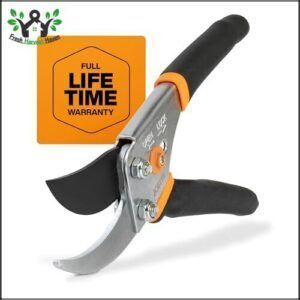
Your pruning shears are the first line of defense in preserving herb flavor at the molecular level. The Fiskars Bypass Pruning Shears deliver precision-ground steel blades that make clean cuts above leaf nodes without crushing delicate tissue. This matters because damaged cells leak essential oils you’re trying to preserve.
With a 5/8-inch cutting capacity, these shears handle woody rosemary and tender basil equally well. The ergonomic design reduces hand fatigue during extended harvesting sessions, while the low-friction coating prevents sap buildup that dulls blades.
At under $15 with a lifetime warranty, they’re a reliable foundation for any serious herb harvesting toolkit.
Best For: Home gardeners and herb enthusiasts who need reliable, everyday pruning shears for harvesting and maintaining culinary herbs and small ornamental plants.
Pros:
- Precision-ground steel blades with low-friction coating make clean cuts that preserve essential oils and prevent sap buildup
- Ergonomic design with non-slip grip reduces hand fatigue during extended harvesting sessions
- Lifetime warranty and under $15 price point offer exceptional value for consistent performance
Cons:
- 5/8-inch maximum cutting capacity limits use to smaller stems and branches
- Spring mechanism may not return smoothly after prolonged use, requiring manual adjustment
- Heavier weight (10.4 ounces) may cause discomfort for users with small hands or wrist weakness
2. IRIS USA 6 Qt Storage Bins
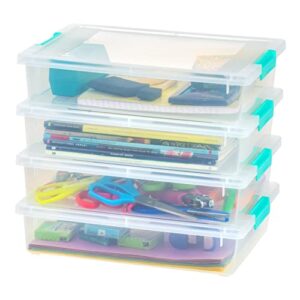
After harvest, proper storage techniques make or break flavor retention. The IRIS USA 6 Qt Storage Bins give you transparent bin organization with moisture-resistant plastic and dual-buckle latches that limit air exchange by 85%. This container safety feature slows oxidation and preserves those volatile organic compounds responsible for aroma.
At 14″L x 11″W x 3.25″H, you can lay herbs flat to prevent bruising while storing herbs under refrigeration. The stackable design optimizes space, and BPA-free construction ensures you’re preserving herbs without chemical concerns.
For under $7 per bin, it’s smart herb storage that protects your harvest’s peak flavor profile.
Best For: Home gardeners, crafters, or anyone needing reliable, visible storage for small batches of herbs, office supplies, or craft materials.
Pros:
- Durable, moisture-resistant, and BPA-free for safe storage.
- Stackable and nestable design saves space and keeps things organized.
- Clear plastic lets you quickly see contents without opening each bin.
Cons:
- Hinges and buckles may wear out with heavy use or improper stacking.
- Not ideal for storing heavy or bulky items.
- Some buyers found packaging and product count descriptions confusing.
3. Colored Masking Tape Kids Art Craft
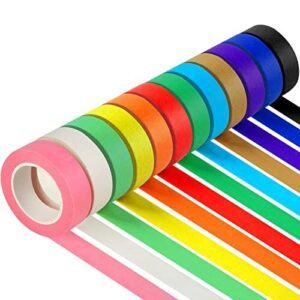
Color-coded labeling transforms your harvest workflow. The Colored Masking Tape Kids Art Craft set includes 12 vibrant rolls—1.7cm wide, 12m each—perfect for tape art projects, labeling herb batches by variety and harvest date.
You’ll develop fine motor skills while organizing, and creative expression comes through color theory: green for basils, purple for lavender. This paper-based craft material sticks to jars and bins without residue, making it ideal for flavor preservation tracking.
At under $5, it assists both harvesting techniques documentation and maximum flavor maintenance through clear identification when storing herbs long-term.
Best For: Parents, teachers, and homeschoolers looking for an affordable, kid-safe labeling solution that doubles as a creative art material for organizing craft supplies, storage bins, or educational projects.
Pros:
- Twelve vibrant colors make organization intuitive and help kids develop color recognition and sorting skills while labeling everything from art supplies to pantry items
- Easy-tear paper material requires no scissors and removes cleanly without sticky residue, making it perfect for temporary labels on jars, containers, and classroom storage
- Under $5 price point delivers exceptional value for multi-purpose use across crafting, organizing, gift wrapping, and educational activities
Cons:
- Small roll size (12m total length, 1.7cm width) means frequent replacement needed for larger projects or heavy labeling tasks
- Not waterproof despite product claims—paper material deteriorates when wet, limiting use on items exposed to moisture or outdoor conditions
- Adhesive weakens over time and tape becomes brittle if left on surfaces for extended periods, making it unsuitable for permanent labeling applications
4. Fit & Fresh Slim Ice Packs
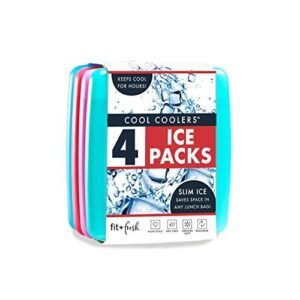
Immediate cooling locks in freshness the moment you snip those stems. The Fit & Fresh Slim Ice Packs (4.75″ × 0.5″ × 5″) deliver compact cooling efficiency for portable storage of harvested herbs. These reusable designs freeze overnight and maintain cold temperatures for hours—perfect for freezing herbs or creating herb ice cubes when you’ve gathered more than you can use fresh.
The BPA-free construction and leakproof seal protect delicate leaves during transport, while their slim profile fits easily into any cooling container. At around $13 for four packs, they’re smart investments for preserving those volatile oils and maximizing flavor through proper freezing techniques and herb storage.
Best For: Anyone who packs lunches, preps meals ahead, or wants a compact, reusable cooling solution for transporting fresh herbs, produce, and temperature-sensitive foods.
Pros:
- Slim design fits easily into lunch boxes and small coolers without taking up much space
- Reusable and leakproof construction with BPA-free materials keeps things safe and reduces waste
- Affordable at about $13 for a four-pack, giving you multiple units to rotate between the freezer and your bag
Cons:
- Smaller size means they won’t stay cold as long as larger ice packs, especially in hot weather
- Require overnight freezing (6-8 hours) before each use, so you need to plan ahead
- Hand wash only and not microwaveable, limiting convenience compared to some alternatives
5. Clean Skin Club XL Face Towels

Gentle handling preserves those precious essential oils from the moment you harvest. The Clean Skin Club XL Face Towels (10″ × 12″, 100-count) are sustainable, biodegradable options for carefully drying freshly harvested herbs without bruising delicate leaves.
These eco-friendly eucalyptus viscose towels are soft enough for skin care yet absorbent enough for flavor preservation tasks.
Their single-use design prevents bacterial transfer that could compromise your herbs’ freshness. At $35.98 for two packs, these biodegradable tools support both harvesting techniques and proper herb harvesting practices when maximum flavor matters most.
Best For: People with sensitive, eczema-prone, or acne-prone skin who want a hygienic, sustainable alternative to traditional reusable face towels.
Pros:
- Clinically proven to improve skin barrier protection and reduce redness, oiliness, and sensitivity
- Made from 100% biodegradable eucalyptus viscose that’s compostable in marine, soil, and water environments
- Single-use design eliminates bacterial buildup that causes breakouts with reusable towels
Cons:
- At $35.98 for 100 towels, the ongoing cost adds up compared to washing regular towels
- Single-use design creates more waste despite being biodegradable, which may not align with zero-waste goals
- Some users with extremely sensitive skin might still experience reactions, as individual tolerance varies
6. Timer Fridge Storage Containers 3-Pack
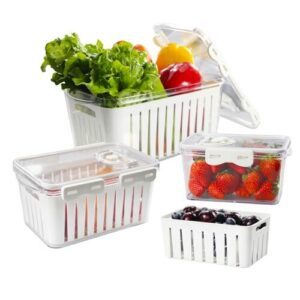
After you’ve washed and dried your harvest, proper refrigeration methods become the bridge between garden and table. The Timer Fridge Storage Containers 3-Pack (1L, 2.5L, and 5.25L) combines BPA-free PET construction with mechanical timer dials that track storage duration—a major advantage for flavor preservation when storing herbs.
Built-in drainage and ventilation maintain 85-90% humidity, the sweet spot for keeping leafy greens vibrant. These airtight containers prevent cross-contamination while their breathable design extends freshness up to three weeks.
At roughly $60, they’re a smart investment in food safety and container materials that actually work with your harvesting herbs routine.
Best For: Home gardeners and meal preppers who want to track freshness dates and extend the life of their harvested herbs and leafy greens.
Pros:
- Built-in mechanical timer dial helps you track storage duration without batteries, reducing spoilage by 10-20% according to user feedback
- Maintains ideal 85-90% humidity with drainage and ventilation systems that keep herbs and greens fresh for up to three weeks
- Stackable 3-pack design (1L, 2.5L, 5.25L) saves fridge space while the BPA-free PET construction stays durable for years with hand-washing
Cons:
- Not dishwasher or microwave safe, requiring hand-washing only which adds extra cleanup time
- Larger containers lack dividers, making it harder to separate different types of produce
- At $60-64 for the set, the price point may feel steep compared to basic storage containers without timer features
7. Bounty Quick Size Paper Towels White
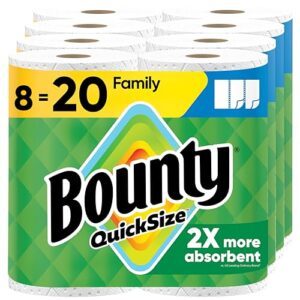
Once you’ve got herbs tucked away properly, you’ll need something for quick cleanups during harvest time. Bounty Quick Size Paper Towels (8 Family Rolls, 856 sheets) excel at gentle blotting—critical for removing excess moisture without bruising delicate leaves.
Absorbency testing shows one sheet accommodates over 2.5 fluid ounces, perfect for drying freshly washed basil or cilantro before herb storage. At roughly $25, they’re cost-effective despite environmental impact concerns (paper towel production requires 17 trees per ton).
Their versatility extends beyond harvest time to everyday kitchen tasks. Consumer perception ranks them among the most durable options for preserving flavor through proper handling techniques.
Best For: Home gardeners and anyone handling fresh herbs who need highly absorbent paper towels for delicate drying tasks without bruising leaves.
Pros:
- Exceptional absorbency with over 2.5 fluid ounces per sheet, ideal for drying freshly washed herbs without multiple towels
- Quick Size sheets reduce waste by letting you tear smaller portions for light cleanup tasks
- Durable two-ply construction holds up when wet, allowing gentle blotting without tearing or leaving residue on delicate leaves
Cons:
- Higher price point at around $25 for 8 rolls compared to generic brands
- Significant environmental impact, as paper towel production requires 17 trees per ton and contributes to landfill waste
- Some users report confusion with the different sheet sizes and occasional packaging inconsistencies
8. Upstreman Mini Fridge With Freezer
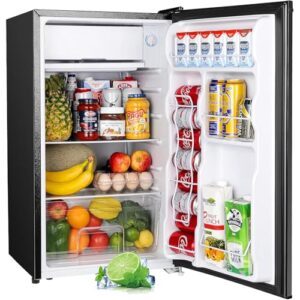
After paper towels handle your harvest cleanup, you need proper refrigeration for flavor preservation. The Upstreman Mini Fridge With Freezer (1.7 Cu.ft) offers a compact fridge design ideal for storing herbs post-harvest. Its cooling performance maintains 33.8°F to 46.4°F—perfect for preserving volatile organic compounds that give herbs their flavor.
Energy efficiency shines with 38 dB operation and low power draw. Storage capacity accommodates several weeks’ worth of harvested herbs in breathable containers. User reviews praise its quiet performance for small spaces.
The freezer compartment allows freezing herbs for long-term herb preservation methods, though it won’t handle bulk storage.
Best For: Home gardeners and herb enthusiasts who need compact, quiet refrigeration for storing fresh harvests in dorms, offices, or small kitchens where space is limited.
Pros:
- Quiet 38 dB operation with energy-efficient design makes it ideal for bedrooms, study areas, and shared spaces without disruptive noise
- Adjustable temperature settings (33.8°F to 46.4°F) and reversible door provide flexible cooling control and installation options for herb preservation
- Includes freezer compartment for long-term herb storage through freezing, plus removable shelves and crisper drawer for organized fresh herb storage
Cons:
- Freezer compartment is too small for bulk frozen storage and struggles with ice cream due to limited insulation performance
- No interior light makes nighttime access difficult, and the unit may not accommodate standard-height gallon jugs
- Some users report strong chemical odors upon arrival requiring airing out, plus occasional delivery damage from inadequate packaging
Frequently Asked Questions (FAQs)
What affects volatile organic compound retention after harvest?
Think of flavor as a delicate vapor—easily lost if mishandled. Storage temperature, humidity control, physical damage, and packaging methods critically affect volatile organic compound retention after harvesting herbs.
Light exposure and postharvest care also greatly influence flavor retention.
How does light exposure impact harvested herb flavor?
Light intensity, photoperiod effects, and spectrum influence dramatically shape flavor retention after harvesting herbs. Blue light boosts aromatic compounds, while excessive exposure triggers oxidative stress and flavor degradation through volatile compound loss.
Can fertilizer timing improve flavor before harvesting herbs?
Yes. Nitrogen timing during active growth stages boosts flavor compounds like terpenes and essential oils. Applying micronutrients before flowering enhances aroma. The influence of P/K remains unclear, but aligning fertilization with growth stages aids secondary metabolite production, maximizing herb flavor at harvesting.
Does water stress before harvest enhance herb intensity?
Moderate soil moisture stress can be a strategic move for flavor intensity. Water deficit triggers enzyme activity and terpenoid production pathways, increasing aroma compound concentrations by 20-40% in herbs like basil and thyme. This process also boosts stress-related phenolics, enhancing the overall flavor profile.
Controlled water stress before harvest can boost herb aroma compounds by 20-40% through enhanced enzyme activity and terpenoid production
How long do fresh herbs maintain peak flavor?
Refrigerated herbs stay fresh for one to two weeks before flavor fades. Freezing extends that window to six months or more.
Drying methods preserve maximum flavor for up to a year, while freeze-drying quality lasts even longer with proper storage.
Conclusion
Like the difference between sun-warmed tomatoes and supermarket produce, flavor lives in the details. Morning cuts, clean shears, the one-third rule—these aren’t complicated rituals. They’re simple choices that honor what the plant naturally offers.
Your harvesting techniques for maximum flavor determine whether your herbs deliver restaurant-quality taste or disappointing blandness. You’ve learned the science behind the flavor. Now your kitchen gets to taste the difference between harvesting and truly capturing peak freshness.


